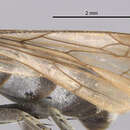Comprehensive Description
provided by Memoirs of the American Entomological Society
Anoplius (Anopliodes) chiriqui new species
Holotype. — $ , Panama: Boquete, Chiriqui Prov., 7 May (G. B. Fairchild) [MCZ, no. 30, 969].
This species is extremely similar to parsonsi, differing only in details of the male genitalia and secondary sexual characters. The female is unknown, but may possibly be the Panama females referred to parsonsi above.
Description of type male. — Length 10 mm.; fore wing 8.2 mm. Black, posterior margin of pronotum with a pale yellow stripe; wings hyaline, conspicuously infuscated along outer margin. Head and thorax extensively silverypubescent, dark only on upper part of head and parts of thoracic terga, basal half of propodeum, and metapleura; first three abdominal sternites silvery, first three tergites with basal silvery bands, tergites 5-7 with apical silvery spots. Head 1.15 X as wide as high; clypeus about twice as wide as high, its apical margin weakly concave. MID .61 X TFD; eyes convergent at the top, UID .92 X LID; OOL slightly exceeding POL. Third antennal segment 2.3 X as long as wide, slightly longer than fourth segment. Pronotum rather short, angulate behind. Propodeum with the slope very low, clothed with the usual white hairs. Longer spur of hind tibia three fourths the length of the basitarsus. SMC2 narrowed by two thirds above; SMC3 about as wide above as the second. Abdominal venter with sparse, short, relatively inconspicuous setae, these setae no longer or more abundant on S4 than elsewhere. SGP tectiform, rounded apically. Genitalia as shown in fig. 41, resembling closely those of varius and parsonsi, but the digiti subtruncate apically, covered with short setae which are mostly straight, but some of them angulate apically.
Distribution. — Panama and Costa Rica. (Map 42.) Paratypes. — Costa Rica: 2 $ $, Golfito, Dept. Puntarenas, 1948 (P. & D. Allen) [MCZ, USNM].
Variation. — The two paratypes are similar to the type in size (fore wing 8.5 and 8.8 mm.) and in coloration of the body and pubescence. In both specimens the costal cell of the fore wing is infuscated, and there is a weak fuscous band over the basal vein. Head measurements are virtually the same as in the type except that in one specimen POL and OOL are equal.
- bibliographic citation
- Evans, H.E. 1966. A Revision of the Mexican and Central American Spider Wasps of the Subfamily Pompilinae (Hymenoptera: Pompilidae). Memoirs of the American Entomological Society vol. 20. Philadelphia, USA

